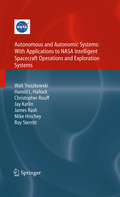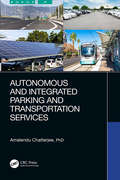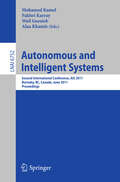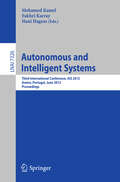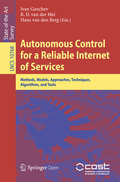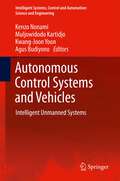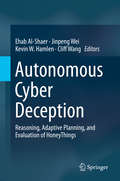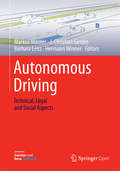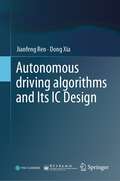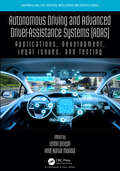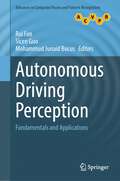- Table View
- List View
Autonomous and Autonomic Systems: With Applications To Nasa Intelligent Spacecraft Operations And Exploration Systems (NASA Monographs in Systems and Software Engineering)
by Walt Truszkowski Harold Hallock Christopher Rouff Jay Karlin James Rash Michael Hinchey Roy SterrittIn the early 1990s, NASA Goddard Space Flight Center started researching and developing autonomous and autonomic ground and spacecraft control systems for future NASA missions. This research started by experimenting with and developing expert systems to automate ground station software and reduce the number of people needed to control a spacecraft. This was followed by research into agent-based technology to develop autonomous ground c- trol and spacecraft. Research into this area has now evolved into using the concepts of autonomic systems to make future space missions self-managing and giving them a high degree of survivability in the harsh environments in which they operate. This book describes much of the results of this research. In addition, it aimstodiscusstheneededsoftwaretomakefutureNASAspacemissionsmore completelyautonomousandautonomic.Thecoreofthesoftwareforthesenew missions has been written for other applications or is being applied gradually in current missions, or is in current development. It is intended that this book should document how NASA missions are becoming more autonomous and autonomic and should point to the way of making future missions highly - tonomous and autonomic. What is not covered is the supporting hardware of these missions or the intricate software that implements orbit and at- tude determination, on-board resource allocation, or planning and scheduling (though we refer to these technologies and give references for the interested reader).
Autonomous and Integrated Parking and Transportation Services
by Amalendu ChatterjeeIn this book, the author outlines a Robust Web Parking, Truck and Transportation Portal (RWPTTP) for integrating parking and transportation services – a revolutionary approach in contrast to incremental change for managing traffic congestion. Autonomous vehicle technology, artificial intelligence, internet of things (IOT), and other interconnected hardware and software tools will assist autonomous parking and transportation services and provide next-century infrastructure for consolidated transportation customer services. The book highlights currently available autonomous parking and transportation technologies, and the development of an integrated and intelligent transportation service/system (IITS) platform, with specific use of technologies to reconfigure the transportation industry. The author also suggests many regulatory and policy changes to simplify data collection, traffic operation, introduction of a duplicate transportation system using light rail (LRs) and high speed rail (SPRs), and redistribution of parking spaces along such routes, using renewable energy.
Autonomous and Intelligent Systems: Second International Conference, AIS 2011, Burnaby, BC, Canada, June 22-24, 2011, Proceedings (Lecture Notes in Computer Science #6752)
by Mohamed Kamel Fakhri Karray Wail Gueaieb Alaa KhamisThis book constitutes the refereed proceedings of the Second International Conference on Autonomous and Intelligent Systems, AIS 2011, held in Burnaby, BC, Canada, in June 2011, colocated with the International Conference on Image Analysis and Recognition, IACIAR 2011. The 40 revised full papers presented were carefully reviewed and selected from 62 submissions. The papers are organized in topical sections on autonomous and intelligent systems, intelligent and advanced control systems, intelligent sensing and data analysis, human-machine interaction, and intelligent circuit analysis and signal processing.
Autonomous and Intelligent Systems: Third International Conference, AIS 2012, Aviero, Portugal, June 25-27, 2012, Proceedings (Lecture Notes in Computer Science #7326)
by Mohamed Kamel Fakhri Karray Hani HagrasThis book constitutes the refereed proceedings of the Third International Conference on Autonomous and Intelligent Systems, AIS 2012, held in Aveiro, Portugal, in June 2012, collocated with the International Conference on Image Analysis and Recognition, IACIAR 2012. The 31 revised full papers were carefully reviewed and selected from 48 submissions. The papers are organized in topical sections on autonomous sensors and sensor systems, autonomous systems and intelligent control with applications, intelligent fuzzy systems, intelligent robotics, intelligent knowledge management, swarm and evolutionary methods, and applications
Autonomous Consumer Business
by Julian MorgenEine immer mehr digital vernetzte Welt führt zu einer sehr großen Menge von unterschiedlichen Daten, die in Echtzeit generiert werden („Big Data“). Ein großer Teil dieser Datenproduzenten sind Nutzer von Social Media oder auch smarten Geräten, wie bspw. Fitnesstrackern oder mit dem Internet verbundenen Waschmaschinen („IoT“). Unternehmen, die sich diese Daten aus der direkten Lebenswelt der Konsumenten zu Nutze machen, können sehr präzise Einblicke bspw. über Einstellungen, Verhalten oder auch die Bedürfnisse potenzieller Kunden erhalten, wodurch der Weg zu einer „automatisierten Vermarktung“ geebnet wird. Zielsetzung dieses Buches ist die Entwicklung eines Konzeptes für ein Autonomous Consumer Business (ACB), das als maximal eigenständig agierendes und durch Künstliche Intelligenz getragenes Geschäftsmodell verstanden wird, bei dem Unternehmen die Bedürfnisse auf der Konsumentenseite automatisch erkennen und durch entsprechende Leistungsangebote befriedigen können. Weiterhin werden zentrale Bestimmungsgrößen, welche die konsumentenseitige Inanspruchnahme eines ACB im besonderen Maße beeinflussen, sowie potenzielle Kundengruppen empirisch identifiziert, wodurch Hinweise zur konkreten Ausgestaltung eines ACB gewonnen werden können.
Autonomous Control for a Reliable Internet of Services: Methods, Models, Approaches, Techniques, Algorithms, and Tools (Lecture Notes in Computer Science #10768)
by Ivan Ganchev R. D. van der Mei Hans van den BergThis open access book was prepared as a Final Publication of the COST Action IC1304 “Autonomous Control for a Reliable Internet of Services (ACROSS)”. The book contains 14 chapters and constitutes a show-case of the main outcome of the Action in line with its scientific goals. It will serve as a valuable reference for undergraduate and post-graduate students, educators, faculty members, researchers, engineers, and research strategists working in this field. The explosive growth of the Internet has fundamentally changed the global society. The emergence of concepts like SOA, SaaS, PaaS, IaaS, NaaS, and Cloud Computing in general has catalyzed the migration from the information-oriented Internet into an Internet of Services (IoS). This has opened up virtually unbounded possibilities for the creation of new and innovative services that facilitate business processes and improve the quality of life. However, this also calls for new approaches to ensuring the quality and reliability of these services. The objective of this book is, by applying a systematic approach, to assess the state-of-the-art and consolidate the main research results achieved in this area.
Autonomous Control Systems and Vehicles: Intelligent Unmanned Systems (Intelligent Systems, Control and Automation: Science and Engineering #65)
by Kenzo Nonami, Muljowidodo Kartidjo, Kwang-Joon Yoon and Agus BudiyonoThe International Conference on Intelligent Unmanned Systems 2011 was organized by the International Society of Intelligent Unmanned Systems and locally by the Center for Bio-Micro Robotics Research at Chiba University, Japan. The event was the 7th conference continuing from previous conferences held in Seoul, Korea (2005, 2006), Bali, Indonesia (2007), Nanjing, China (2008), Jeju, Korea (2009), and Bali, Indonesia (2010). ICIUS 2011 focused on both theory and application, primarily covering the topics of robotics, autonomous vehicles, intelligent unmanned technologies, and biomimetics. We invited seven keynote speakers who dealt with related state-of-the-art technologies including unmanned aerial vehicles (UAVs) and micro air vehicles (MAVs), flapping wings (FWs), unmanned ground vehicles (UGVs), underwater vehicles (UVs), bio-inspired robotics, advanced control, and intelligent systems, among others. This book is a collection of excellent papers that were updated after presentation at ICIUS2011. All papers that form the chapters of this book were reviewed and revised from the perspective of advanced relevant technologies in the field. The aim of this book is to stimulate interactions among researchers active in the areas pertinent to intelligent unmanned systems.
Autonomous Cyber Deception: Reasoning, Adaptive Planning, and Evaluation of HoneyThings
by Cliff Wang Ehab Al-Shaer Jinpeng Wei Kevin W. HamlenThis textbook surveys the knowledge base in automated and resilient cyber deception. It features four major parts: cyber deception reasoning frameworks, dynamic decision-making for cyber deception, network-based deception, and malware deception. An important distinguishing characteristic of this book is its inclusion of student exercises at the end of each chapter. Exercises include technical problems, short-answer discussion questions, or hands-on lab exercises, organized at a range of difficulties from easy to advanced,. This is a useful textbook for a wide range of classes and degree levels within the security arena and other related topics. It’s also suitable for researchers and practitioners with a variety of cyber security backgrounds from novice to experienced.
Autonomous Data Security: Creating a Proactive Enterprise Protection Plan
by Priyanka NeelakrishnanThis book focuses on analyzing the foundational requirements necessary to construct an autonomous data protection solution for enterprise businesses. It navigates readers through various options and tools, outlining the advantages and disadvantages of each. Covering diverse deployment environments including cloud, on-premises, and hybrid setups, as well as different deployment scales and comprehensive channel coverages, it encourages readers to break away from conventional norms in their approach. By exploring the factors that should be taken into account, the book highlights the significant gap in existing data safeguarding solutions, which often rely solely on configured security policies. It proposes a forward-thinking security approach designed to endure over time, surpassing traditional policies and urging readers to consider proactive autonomous data security solutions. Additionally, it delves into the system's ability to adapt to deployed environments, learn from feedback, and autonomously safeguard data while adhering to security policies. More than just a set of guidelines, this book serves as a catalyst for the future of the cybersecurity industry. Its focus on autonomous data security and its relevance in the era of advancing AI make it particularly timely and essential. What You Will learn: Understand why data security is important for enterprise businesses. How data protection solutions work and how to evaluate a solution in the market. How to start thinking and evaluating requirements when building a solution for small, medium, and large enterprises. Understand the pros and cons of security policy configurations defined by administrators and why can’t they provide comprehensive protection. How to safeguard data via adaptive learning from the deployed environment – providing autonomous data security with or without policies. How to leverage AI to provide data security with comprehensive proactive protection. What factors to consider when they have to protect and safeguard data. Who this book is for: The primary audience is cybersecurity professionals, security enthusiasts, C-level executives in organizations (all verticals), and security analysts and IT administrators. Secondary audience includes professors and teachers, channel integrators, professional services, and hackers.
Autonomous Driving: Technical, Legal and Social Aspects
by Markus Maurer J. Christian Gerdes Barbara Lenz Hermann WinnerThis book takes a look at fully automated, autonomous vehicles and discusses many open questions: How can autonomous vehicles be integrated into the current transportation system with diverse users and human drivers? Where do automated vehicles fall under current legal frameworks? What risks are associated with automation and how will society respond to these risks? How will the marketplace react to automated vehicles and what changes may be necessary for companies?Experts from Germany and the United States define key societal, engineering, and mobility issues related to the automation of vehicles. They discuss the decisions programmers of automated vehicles must make to enable vehicles to perceive their environment, interact with other road users, and choose actions that may have ethical consequences. The authors further identify expectations and concerns that will form the basis for individual and societal acceptance of autonomous driving. While the safety benefits of such vehicles are tremendous, the authors demonstrate that these benefits will only be achieved if vehicles have an appropriate safety concept at the heart of their design. Realizing the potential of automated vehicles to reorganize traffic and transform mobility of people and goods requires similar care in the design of vehicles and networks. By covering all of these topics, the book aims to provide a current, comprehensive, and scientifically sound treatment of the emerging field of “autonomous driving".
Autonomous driving algorithms and Its IC Design
by Jianfeng Ren Dong XiaWith the rapid development of artificial intelligence and the emergence of various new sensors, autonomous driving has grown in popularity in recent years. The implementation of autonomous driving requires new sources of sensory data, such as cameras, radars, and lidars, and the algorithm processing requires a high degree of parallel computing. In this regard, traditional CPUs have insufficient computing power, while DSPs are good at image processing but lack sufficient performance for deep learning. Although GPUs are good at training, they are too “power-hungry,” which can affect vehicle performance. Therefore, this book looks to the future, arguing that custom ASICs are bound to become mainstream. With the goal of ICs design for autonomous driving, this book discusses the theory and engineering practice of designing future-oriented autonomous driving SoC chips.The content is divided into thirteen chapters, the first chapter mainly introduces readers to the current challenges and research directions in autonomous driving. Chapters 2–6 focus on algorithm design for perception and planning control. Chapters 7–10 address the optimization of deep learning models and the design of deep learning chips, while Chapters 11-12 cover automatic driving software architecture design. Chapter 13 discusses the 5G application on autonomous drving. This book is suitable for all undergraduates, graduate students, and engineering technicians who are interested in autonomous driving.
Autonomous Driving and Advanced Driver-Assistance Systems: Applications, Development, Legal Issues, and Testing (Chapman & Hall/CRC Artificial Intelligence and Robotics Series)
by Lentin JosephAutonomous Driving and Advanced Driver-Assistance Systems (ADAS): Applications, Development, Legal Issues, and Testing outlines the latest research related to autonomous cars and advanced driver-assistance systems, including the development, testing, and verification for real-time situations of sensor fusion, sensor placement, control algorithms, and computer vision. Features: Co-edited by an experienced roboticist and author and an experienced academic Addresses the legal aspect of autonomous driving and ADAS Presents the application of ADAS in autonomous vehicle parking systems With an infinite number of real-time possibilities that need to be addressed, the methods and the examples included in this book are a valuable source of information for academic and industrial researchers, automotive companies, and suppliers.
Autonomous Driving and Advanced Driver-Assistance Systems: Applications, Development, Legal Issues, and Testing (Chapman & Hall/CRC Artificial Intelligence and Robotics Series)
by Lentin Joseph Amit Kumar MondalAutonomous Driving and Advanced Driver-Assistance Systems (ADAS): Applications, Development, Legal Issues, and Testing outlines the latest research related to autonomous cars and advanced driver-assistance systems, including the development, testing, and verification for real-time situations of sensor fusion, sensor placement, control algorithms, and computer vision. Features: Co-edited by an experienced roboticist and author and an experienced academic Addresses the legal aspect of autonomous driving and ADAS Presents the application of ADAS in autonomous vehicle parking systems With an infinite number of real-time possibilities that need to be addressed, the methods and the examples included in this book are a valuable source of information for academic and industrial researchers, automotive companies, and suppliers.
Autonomous Driving Network: Network Architecture in the Era of Autonomy
by Wenshuan Dang River Huang Yijun Yu Yong ZhangAiming to outline the vision of realizing automated and intelligent communication networks in the era of intelligence, this book describes the development history, application scenarios, theories, architectures, and key technologies of Huawei's Autonomous Driving Network (ADN) solution. In the book, the authors explain the design of the top-level architecture, hierarchical architecture (ANE, NetGraph, and AI Native NE), and key feature architecture (distributed AI and endogenous security) that underpin Huawei's ADN solution. The book delves into various key technologies, including trustworthy AI, distributed AI, digital twin, network simulation, digitization of knowledge and expertise, human-machine symbiosis, NE endogenous intelligence, and endogenous security. It also provides an overview of the standards and level evaluation methods defined by industry and standards organizations, and uses Huawei's ADN solution as an example to illustrate how to implement AN. This book is an essential reference for professionals and researchers who want to gain a deeper understanding of automated and intelligent communication networks and their applications.
Autonomous Driving Network: Network Architecture in the Era of Autonomy
by Wenshuan Dang River Huang Yijun Yu Yong ZhangAiming to outline the vision of realizing automated and intelligent communication networks in the era of intelligence, this book describes the development history, application scenarios, theories, architectures, and key technologies of Huawei's Autonomous Driving Network (ADN) solution. In the book, the authors explain the design of the top-level architecture, hierarchical architecture (ANE, NetGraph, and AI Native NE), and key feature architecture (distributed AI and endogenous security) that underpin Huawei's ADN solution. The book delves into various key technologies, including trustworthy AI, distributed AI, digital twin, network simulation, digitization of knowledge and expertise, human-machine symbiosis, NE endogenous intelligence, and endogenous security. It also provides an overview of the standards and level evaluation methods defined by industry and standards organizations, and uses Huawei's ADN solution as an example to illustrate how to implement AN. This book is an essential reference for professionals and researchers who want to gain a deeper understanding of automated and intelligent communication networks and their applications.
Autonomous Driving Perception: Fundamentals and Applications (Advances in Computer Vision and Pattern Recognition)
by Rui Fan Sicen Guo Mohammud Junaid BocusDiscover the captivating world of computer vision and deep learning for autonomous driving with our comprehensive and in-depth guide. Immerse yourself in an in-depth exploration of cutting-edge topics, carefully crafted to engage tertiary students and ignite the curiosity of researchers and professionals in the field. From fundamental principles to practical applications, this comprehensive guide offers a gentle introduction, expert evaluations of state-of-the-art methods, and inspiring research directions. With a broad range of topics covered, it is also an invaluable resource for university programs offering computer vision and deep learning courses. This book provides clear and simplified algorithm descriptions, making it easy for beginners to understand the complex concepts. We also include carefully selected problems and examples to help reinforce your learning. Don't miss out on this essential guide to computer vision and deep learning for autonomous driving.
Autonomous Dynamic Reconfiguration in Multi-Agent Systems: Improving the Quality and Efficiency of Collaborative Problem Solving (Lecture Notes in Computer Science #2427)
by Markus HannebauerHigh communication efforts and poor problem solving results due to restricted overview are two central issues in collaborative problem solving. This work addresses these issues by introducing the processes of agent melting and agent splitting that enable individual problem solving agents to continually and autonomously reconfigure and adapt themselves to the particular problem to be solved. The author provides a sound theoretical foundation of collaborative problem solving itself and introduces various new design concepts and techniques to improve its quality and efficiency, such as the multi-phase agreement finding protocol for external problem solving, the composable belief-desire-intention agent architecture, and the distribution-aware constraint specification architecture for internal problem solving. The practical relevance and applicability of the concepts and techniques provided are demonstrated by using medical appointment scheduling as a case study.
The Autonomous Enterprise: Powered by AI
by Sarah BurnettThe journey towards the autonomous enterprise has begun; there are already companies operating in a highly automated way and with artificial intelligence (AI) solutions offering compelling returns on investment. More organisations will be joining their ranks. With a workforce of machines that are augmented by humans, the autonomous enterprise will turn the current organisational model on its head. Corporate decision-makers will need to understand the opportunities and risks that the autonomous enterprise presents, to learn how best to navigate the shifting competitive landscape on their journey of change. This book is your guide to this innovation, presenting the concepts in real world contexts by covering the art of the possible today and providing glimpses into the future of business.
The Autonomous Enterprise: Powered by AI
by Sarah BurnettThe journey towards the autonomous enterprise has begun; there are already companies operating in a highly automated way and with artificial intelligence (AI) solutions offering compelling returns on investment. More organisations will be joining their ranks. With a workforce of machines that are augmented by humans, the autonomous enterprise will turn the current organisational model on its head. Corporate decision-makers will need to understand the opportunities and risks that the autonomous enterprise presents, to learn how best to navigate the shifting competitive landscape on their journey of change. This book is your guide to this innovation, presenting the concepts in real world contexts by covering the art of the possible today and providing glimpses into the future of business.
Autonomous Flying Robots: Unmanned Aerial Vehicles and Micro Aerial Vehicles
by Kenzo Nonami Farid Kendoul Satoshi Suzuki Wei Wang Daisuke NakazawaThe advance in robotics has boosted the application of autonomous vehicles to perform tedious and risky tasks or to be cost-effective substitutes for their - man counterparts. Based on their working environment, a rough classi cation of the autonomous vehicles would include unmanned aerial vehicles (UAVs), - manned ground vehicles (UGVs), autonomous underwater vehicles (AUVs), and autonomous surface vehicles (ASVs). UAVs, UGVs, AUVs, and ASVs are called UVs (unmanned vehicles) nowadays. In recent decades, the development of - manned autonomous vehicles have been of great interest, and different kinds of autonomous vehicles have been studied and developed all over the world. In part- ular, UAVs have many applications in emergency situations; humans often cannot come close to a dangerous natural disaster such as an earthquake, a ood, an active volcano, or a nuclear disaster. Since the development of the rst UAVs, research efforts have been focused on military applications. Recently, however, demand has arisen for UAVs such as aero-robotsand ying robotsthat can be used in emergency situations and in industrial applications. Among the wide variety of UAVs that have been developed, small-scale HUAVs (helicopter-based UAVs) have the ability to take off and land vertically as well as the ability to cruise in ight, but their most importantcapability is hovering. Hoveringat a point enables us to make more eff- tive observations of a target. Furthermore, small-scale HUAVs offer the advantages of low cost and easy operation.
Autonomous Guided Vehicles: Methods and Models for Optimal Path Planning (Studies in Systems, Decision and Control #20)
by Hamed Fazlollahtabar Mohammad Saidi-MehrabadThis book provides readers with extensive information on path planning optimization for both single and multiple Autonomous Guided Vehicles (AGVs), and discusses practical issues involved in advanced industrial applications of AGVs. After discussing previously published research in the field and highlighting the current gaps, it introduces new models developed by the authors with the goal of reducing costs and increasing productivity and effectiveness in the manufacturing industry. The new models address the increasing complexity of manufacturing networks, due for example to the adoption of flexible manufacturing systems that involve automated material handling systems, robots, numerically controlled machine tools, and automated inspection stations, while also considering the uncertainty and stochastic nature of automated equipment such as AGVs. The book discusses and provides solutions to important issues concerning the use of AGVs in the manufacturing industry, including material flow optimization with AGVs, programming manufacturing systems equipped with AGVs, reliability models, the reliability of AGVs, routing under uncertainty, and risks involved in AGV-based transportation. The clear style and straightforward descriptions of problems and their solutions make the book an excellent resource for graduate students. Moreover, thanks to its practice-oriented approach, the novelty of the findings and the contemporary topic it reports on, the book offers new stimulus for researchers and practitioners in the broad field of production engineering.
Autonomous Intelligent Cyber Defense Agent: A Comprehensive Guide (Advances in Information Security #87)
by Alexander KottThis book offers a structured overview and a comprehensive guide to the emerging field of Autonomous Intelligent Cyber Defense Agents (AICA). The book discusses the current technical issues in autonomous cyber defense and offers information on practical design approaches. The material is presented in a way that is accessible to non-specialists, with tutorial information provided in the initial chapters and as needed throughout the book. The reader is provided with clear and comprehensive background and reference material for each aspect of AICA.Today’s cyber defense tools are mostly watchers. They are not active doers. They do little to plan and execute responses to attacks, and they don’t plan and execute recovery activities. Response and recovery – core elements of cyber resilience – are left to human cyber analysts, incident responders and system administrators. This is about to change. The authors advocate this vision, provide detailed guide to how such a vision can be realized in practice, and its current state of the art.This book also covers key topics relevant to the field, including functional requirements and alternative architectures of AICA, how it perceives and understands threats and the overall situation, how it plans and executes response and recovery, how it survives threats, and how human operators deploy and control AICA. Additionally, this book covers issues of testing, risk, and policy pertinent to AICA, and provides a roadmap towards future R&D in this field.This book targets researchers and advanced students in the field of cyber defense and resilience. Professionals working in this field as well as developers of practical products for cyber autonomy will also want to purchase this book.
Autonomous Intelligent Systems: Second International Workshop, AIS-ADM 2007, St. Petersburg, Russia, June 3-5, 2007, Proceedings (Lecture Notes in Computer Science #4476)
by Vladimir Gorodetsky Chengqi Zhang Victor Skormin Longbing CaoThis book constitutes the refereed proceedings of the Second International Workshop on Autonomous Intelligent Systems: Agents and Data Mining, AIS-ADM 2007, held in St. Petersburg, Russia in June 2007. The 17 revised full papers and six revised short papers presented together with four invited lectures cover agent and data mining, agent competition and data mining, as well as text mining, semantic Web, and agents.
Autonomous Intelligent Systems: International Workshop, AIS-ADM 2005 (Lecture Notes in Computer Science #3505)
by Vladimir Gorodetsky Jiming Liu Victor A. SkorminAutonomous Intelligent Vehicles: Theory, Algorithms, and Implementation (Advances in Computer Vision and Pattern Recognition)
by Hong ChengThis important text/reference presents state-of-the-art research on intelligent vehicles, covering not only topics of object/obstacle detection and recognition, but also aspects of vehicle motion control. With an emphasis on both high-level concepts, and practical detail, the text links theory, algorithms, and issues of hardware and software implementation in intelligent vehicle research. Topics and features: presents a thorough introduction to the development and latest progress in intelligent vehicle research, and proposes a basic framework; provides detection and tracking algorithms for structured and unstructured roads, as well as on-road vehicle detection and tracking algorithms using boosted Gabor features; discusses an approach for multiple sensor-based multiple-object tracking, in addition to an integrated DGPS/IMU positioning approach; examines a vehicle navigation approach using global views; introduces algorithms for lateral and longitudinal vehicle motion control.
